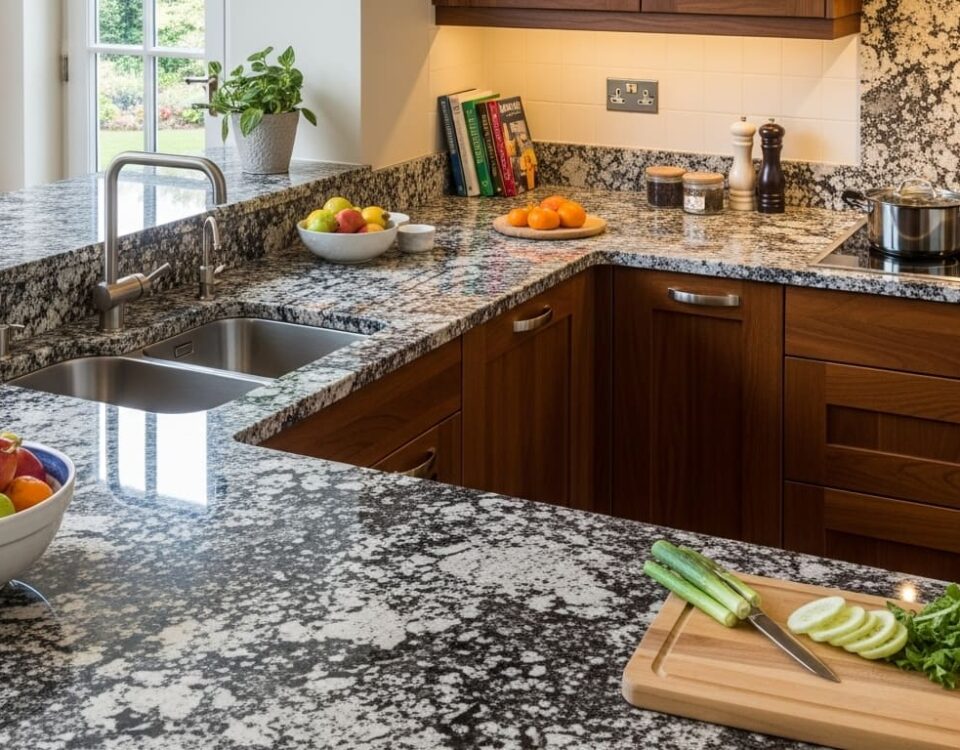The Cost of Quartzite Kitchen Countertops: Budgeting for Your Remodel
June 17, 2024Benefits of Quartzite Vanity Tops for Durability and Style
June 19, 2024Exploring Kitchen Countertop Materials: Pros and Cons
Selecting the appropriate kitchen countertop material is a crucial decision that impacts both the aesthetics and functionality of one of the most used spaces in a home. While granite offers enduring appeal and robustness, its need for periodic sealing may deter some. Quartz counters, albeit resilient and maintenance-free, might lack the natural variances that stone enthusiasts covet. Meanwhile, environmentally conscious consumers may gravitate towards recycled glass, despite its susceptibility to wear. Similarly, butcher block presents a warm, inviting surface yet demands frequent conditioning. Each material’s distinct benefits and limitations must be carefully weighed against the homeowner’s lifestyle and kitchen demands, suggesting a deeper analysis into how these surfaces perform under daily culinary pressures.
Overview of Countertop Materials
Kitchen countertops, the focal point of culinary activity, are crafted from a diverse array of materials, each offering unique advantages and aesthetic appeals. These surfaces not only need to be functional and durable but also harmonize with the overall design of the kitchen, reflecting the homeowner’s style and values.
Among the popular choices, granite stands out for its robustness and classic beauty, each slab boasting unique veining and colorations that promise a one-of-a-kind kitchen centerpiece.
Quartz, engineered from natural minerals combined with resin binders, offers a more uniform appearance and boasts superior durability and stain resistance, making it ideal for busy kitchens.
Laminate countertops provide a budget-friendly alternative, available in an array of colors and patterns, including designs that mimic more expensive materials. This option is particularly appealing for individuals looking to achieve a certain aesthetic without the associated cost.
Wood countertops bring warmth and character to a kitchen, creating a welcoming ambiance that is particularly appealing in homes aiming for a rustic or Scandinavian look. Each type of wood, from maple to walnut, carries distinct grains and tones, thus contributing to the unique feel of each kitchen space.
These materials, among others, provide diverse possibilities for homeowners to express their personal style and fulfill their kitchen needs.
Detailed Comparison and Recommendations
Having explored the variety of materials available for kitchen countertops, let us now examine a detailed comparison and offer recommendations tailored to specific needs and lifestyles.
When selecting a countertop, consider both its aesthetic appeal and functional performance. Quartz, renowned for its durability and low maintenance, stands out as an ideal choice for busy kitchens. Unlike natural stone, it resists staining and does not require periodic sealing.
Granite, with its unique patterns and robustness, is perfect for those who appreciate a kitchen that doubles as a showpiece. However, it does require more upkeep to prevent staining and maintain its beauty.
For eco-conscious consumers, recycled glass presents an innovative and sustainable option, offering a variety of vibrant colors and textures, though it may be prone to chipping and scratching.
Butcher block countertops attract homeowners looking for warmth and a touch of traditional charm. Wood is naturally anti-bacterial and can be sanded and resealed as needed, making it a long-lasting choice if maintained properly.
Ultimately, the decision should align with your personal style, kitchen activity levels, and long-term durability expectations. Each material brings its own set of characteristics, ensuring there’s a perfect match for every home, fostering a sense of belonging and pride in your kitchen space.
Read More:
The Cost of Quartzite Kitchen Countertops: Budgeting for Your Remodel




